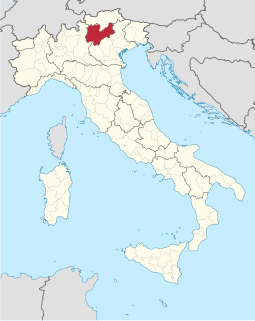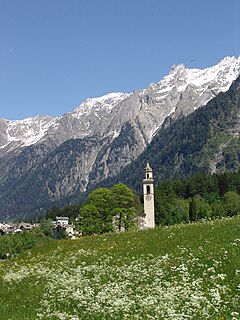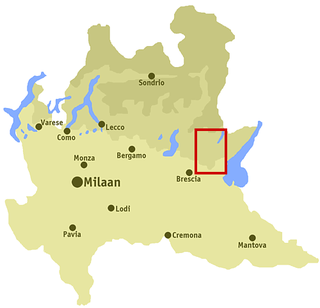
Trento, also anglicized as Trent, is a city on the Adige River in Trentino-Alto Adige/Südtirol in Italy. It is the capital of the autonomous province of Trento. In the 16th century, the city was the location of the Council of Trent. Formerly part of Austria and Austria-Hungary, it was annexed by Italy in 1919. With 118,142 inhabitants, Trento is the third largest city in the Alps and second largest in the historical region of Tyrol.

The river Ticino is the most important perennial left-bank tributary of the Po. It has given its name to the Swiss canton through which its upper portion flows.

Lake Garda is the largest lake in Italy. It is a popular holiday location in northern Italy, about halfway between Brescia and Verona, and between Venice and Milan on the edge of the Dolomites. Glaciers formed this alpine region at the end of the last ice age. The lake and its shoreline are divided between the provinces of Brescia, Verona (south-east) and Trentino (north).

The Province of Brescia is a Province in the Lombardy administrative region of northern Italy. It has a population of some 1,265,964 and its capital is the city of Brescia.

Trentino officially the Autonomous Province of Trento, is an autonomous province of Italy, in the country's far north. The Trentino and South Tyrol constitute the region of Trentino-Alto Adige/Südtirol, an autonomous region under the constitution. The province is composed of 177 comuni (municipalities). Its capital is the city of Trento (Trent). The province covers an area of more than 6,000 km2 (2,300 sq mi), with a total population of 541,098 in 2019. Trentino is renowned for its mountains, such as the Dolomites, which are part of the Alps.

The Vinschgau, Vintschgau or Vinschgau Valley is the upper part of the Adige or Etsch river valley, in the western part of the province of South Tyrol, Italy.

The Sole Valley is a valley in Trentino, northern Italy.

The Val Bregaglia is an alpine valley of Switzerland and Italy at the base of which runs the river Mera.

The Chiese, also known in the Province of Brescia as the Clisi, is a 160-kilometre (99 mi) Italian river that is the principal immisary and sole emissary of the sub-alpine lake Lago d’Idro, and is a left tributary of the Oglio.

The Valle Sabbia is the second-largest of the Tre Valli Bresciane, situated in the eastern part of the province of Brescia.

Val Rendena [German:Randental] is the valley of the Sarca river in Trentino, northern Italy. The valley is part of the Giudicarie. Main towns include Spiazzo Rendena and Pinzolo.

The Rein da Medel is the longest headwater of the Rhine. It is located in the Swiss cantons of Ticino and Graubünden and flows through the valleys Val Cadlimo and Val Medel. Rein da Medel is the local Sursilvan, name in Graubünden, which is commonly used to denote the Ticino part as well.

The Brescia and Garda Prealps are a mountain range in the southern part of the Alps. They are located mainly in Lombardy but also in Trentino Alto Adige and in Veneto, in the northern part of Italy.

Alta Valsugana e Bersntol is one of the sixteen districts of Trentino in the Italian region of Trentino-Alto Adige/Südtirol. Its administrative seat and major town is Pergine Valsugana.

The Garda Mountains, occasionally also the Garda Hills, are an extensive mountain range of the Southern Limestone Alps in northern Italy.

The Po is the longest river in Italy. It flows eastward across northern Italy starting from the Cottian Alps. The river's length is either 652 km (405 mi) or 682 km (424 mi), if the Maira, a right bank tributary, is included. The headwaters of the Po are a spring seeping from a stony hillside at Pian del Re, a flat place at the head of the Val Po under the northwest face of Monviso. The Po then extends along the 45th parallel north before ending at a delta projecting into the Adriatic Sea near Venice.

The Cismon is a mountain stream in northern Italy, the main tributary of the Brenta River. The torrent flows from the Dolomites mountains in the Trentino Alto-Adige region through the plains of Venetian territory to the bigger Brenta River, which in turn flows into the Adriatic Sea in the Gulf of Venice.

The Italian geographical region, Italian physical region or Italian region is a geographical subregion of Southern Europe delimited to the north and west by the mountain chains of the Alps. This subregion is composed of a continental part in the north, a main peninsular part, and an insular part in the south. Located between the Balkan Peninsula and the Iberian Peninsula, it protrudes into the centre of the Mediterranean Sea and overlooks the Adriatic Sea, the Ionian Sea, the Ligurian Sea, the Sardinian Channel, the Sea of Corsica, the Sea of Sardinia, the Strait of Sicily, and the Tyrrhenian Sea.

The Austro-Hungarian fortifications on the Italian border were constructed in the 19th and early 20th centuries to protect against invasion from Italy. Most were built in what is today the Trentino-Alto Adige region; some built outside this territory were ceded to Italy after 1866. By the First World War many of them were obsolete, but nevertheless played a role in deterring and containing Italian assaults.




















